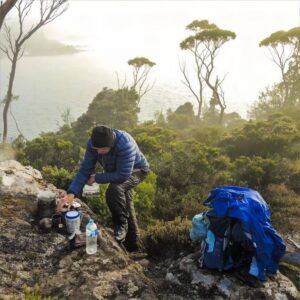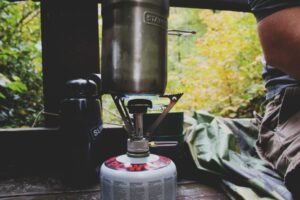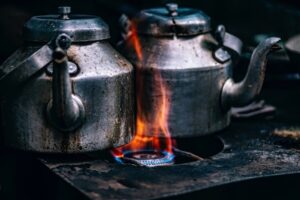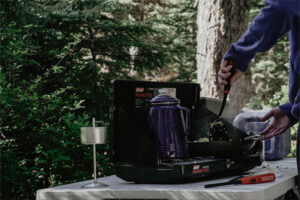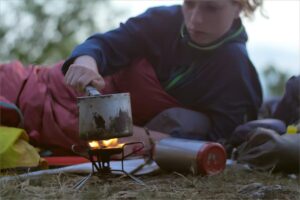
How long does camp stove fuel last?
On high, the most common 8-ounce canister will last for 3 hours. However, the duration of camp stove fuel is governed by the size of the canister that stores the fuel. The majority of firms also sell these canisters in 3.5 and 16-ounce sizes. So, a 3.5-ounce canister will last around 1.5 hours on high, and a 16-ounce canister will last up to 6 hours.
This should give you a good indication of how long your stove fuel will last you during the journey. Assume you’re planning a week-long camping and hiking excursion. If you’re traveling alone, an 8-ounce container should enough. The typical quantity of cooking fuel used for one person on a weeklong vacation is just under 8 ounces, so that should be enough for the week.
How to Calculate Your Fuel Needs?
Once you’ve calculated how much water you’ll need to boil, review your stove’s specifications. You must consider the following important details:
Boil Time indicates how quickly a stove can bring a particular volume of water to a boil under ideal conditions, such as 3 minutes and 30 seconds per liter of water.
Burn Time indicates how long a stove can operate on a specific amount of fuel, such as 60 minutes per 230g canister. (Because some manufacturers specify canister size in oz., you may need to conduct additional unit conversions.)
Variables That Affect Fuel Usage
The specs for your stove were obtained under ideal conditions. Wind, height, air temperature, and other factors may all have an impact on your fuel estimates before you leave. It’s impossible to predict how much the following factors may influence your fuel consumption. If you plan to face any of the following scenarios, make careful to overestimate your gasoline requirements.
Simmering: Are you cooking pasta or another type of food that needs to simmer? Are you melting snow to drink or boiling water to purify it? If so, you’ll need to bring more fuel.
Wind: Wind is the most common environmental factor that can severely impact a backpacking stove’s performance. Windy conditions can literally blow away much of the heat you’re generating with your stove. In fact, if you expect it to be really windy (and you’re not using a windscreen with your stove), experts advise that you take twice as much fuel as you would in perfect conditions.
Air temperature: The temperature of the surrounding air can also have an effect on stove performance and fuel use. Not surprisingly, if the ambient temperature is low, the temperature of any water you gather from the environment is also likely to be low, and bringing that water to a boil will take longer. As a result, you’ll need to use more fuel to attain a full boil. In the backwoods, starting with near-freezing water means it will most likely take several minutes longer to reach a boil.
Elevation: Water’s (or any liquid’s) boiling point changes with the surrounding air pressure. The boiling point decreases as height increases and air pressure decreases (and vice versa). In other words, at higher elevations, water boils quicker.
Even while water boils quicker at altitude, which reduces prep time for dehydrated or freeze-dried foods, some foods take longer to cook because they absorb water more slowly. Cook time will double for every 18 degrees Fahrenheit drop in boiling point (approximately the difference between sea level and 10,000 feet), according to MSR stove maker.
Additionally, stove efficiency at altitude might influence overall fuel use. Fortunately, some stoves are constructed to control fuel pressure, compensating for changes in ambient air pressure. Furthermore, most liquid fuel stoves may be manually pressurized by pumping, mitigating the effects of elevation variation on efficiency.
Tips for Improving Stove Performance
There are a variety of tips and tactics that can increase stove performance and help you utilize your fuel more efficiently, regardless of where you’re going, how long you expect to be out, or how much fuel you plan to bring. Before you turn on your stove, gather all of your cooking supplies and utensils. As a result, you’ll be ready to cook as soon as the stove starts, saving crucial seconds or even minutes of squandering fuel while you fidget with your supplies. To ensure maximum efficiency, run your stove slightly below full power, about a quarter turn less than full output. If you use maximum power, your water will boil faster, but you will squander heat around the sides of the pot and send it into the environment. Put a lid on your saucepan. Water evaporates faster as it warms up. The faster the evaporation rate, the slower the water will boil. Keeping a cover on your pot reduces evaporation and hence the time required to reach a boil.
Make use of a windscreen. Combating the heat-stealing effect of wind makes a significant difference in terms of fuel savings. Yes, a wind screen adds a little amount of weight to your pack, but that weight is mitigated by the fact that you won’t need to bring as much fuel. This only applies to liquid fuel stoves. Canister stoves typically do not require a windscreen since they require heat to escape (but some may have a specifically constructed windscreen).
Learn everything you can about your stove and equipment. Take notes on stove performance and fuel use throughout your outings to help you make better decisions the next time you go away.

